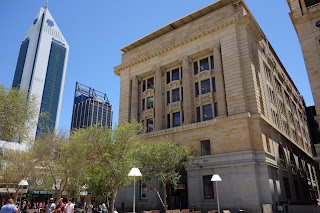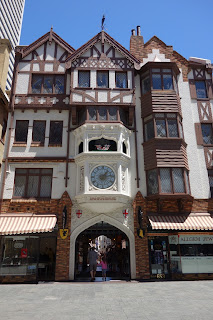As you know I'm in Perth and the city was certainly abuzz with "Australia fever" today... as well it should be. I decided to go into the city to be a part of the action for a little while this afternoon, and while I was there I took myself on one of about 4 self-guided walks that Perth has.
Firstly though, I wandered around the main shopping area for a little bit. Like I've found in Melbourne and Adelaide, there is a section of the Central Business District (CBD) here as well that is pedestrian access only and I have to say I'm quite enjoying them. It is rather nice to be where all the action is happening in the centre of the city and have lots of space - not be confined simply to a sidewalk.
The General Post Office (GPO) in Perth is located in a part of the pedestrian shopping area called Forrest Place. This austere building was completed in 1923 after taking nearly a decade to build as construction was protracted for WW1. At the time of its opening it was the largest building in Perth.
Right beside the Post Office is the Commonwealth Bank Building, built in 1933. These two buildings are the only two original buildings from that time and have certainly seen lots of changes around them as Forrest Place has grown and developed over the years.
The street, Forrest Place, was created in 1923 and named after Sir John Forrest, the first Premier of Western Australia. It has a history of being a focal point for significant political meetings and demonstrations and today is still a great meeting place ... especially if the weather is hot and one of the art works on display is an interactive water feature!
London Court is another section of the pedestrian shopping area. Built in 1937 as a combination of residential and commercial premises for a wealthy gold miner and financier, Claude de Bernales, Perth's London Court is designed using the architectural features present in Elizabethan times. It is said to be the only walk in the world, outside Britain, that has captured a setting and atmosphere so similar to that of Tudor England.
At the main entrance to London Court a blue-faced clock chimes every quarter of an hour. The clock face is a replica of the "great Clock" at Rouen in France. Above the clock four knights, known as "Tournament of Armoured Knights", circle in the window when the clock chimes.
Statues of Sir Walter Raleigh and Dick Whittington stand above the first level facing each other at either end of the Court.
A single dovecote hangs hidden on the side of one of the buildings half way along the Court and six weather vanes are located on top of the buildings. Copper coloured ships decorate the classically moulded ceilings at both entrances to the Court and containers moulded with lions and unicorns line the walkway providing an aesthetically appealing rubbish can!
After leaving London Court I wandered over to the Supreme Court Gardens (I loved these statues at one of the entrances), and to the current Supreme Court building. This building was built in 1902 and is still in use today.
Right beside the current building is the Old Court House, on the original site where it was built. This building was completed in December 1836 and officially opened early in 1837. In addition to being the court house, the building also served as a church and a schoolhouse during its early years, as well it was the only substantial building suitable for larger, public meetings. The building continued to be used by the Arbitration Court until 1965 and it now belongs to the Law Society of Western Australia. The Old Court House is Perth's oldest surviving public building.
The Swan Bells are a set of 18 bells hanging in a specially built 82.5 metres high copper and glass campanile, commonly known as The Bell Tower or the Swan Bell Tower here in Perth. Taking their name from the Swan River, which their tower overlooks, and forming a sixteen-bell peal with two extra chromatic notes, they are one of the largest sets of change ringing bells in the world. Twelve of the set are historic bells from St. Martin-in-the-Fields church in Trafalgar Square in London; six others, cast in recent times by the Whitechapel Bell Foundry, round off the set.
Although I wasn't there to hear the bells ringing yesterday I do hope to get back when they are.
Perth's Town Hall took three years to build, using convict labour, and had it's formal opening in 1870. It was designed on an impressive scale to reflect its important role in the administration of the colony, as well as serving a number of practical purposes. The undercroft of arches formed a covered marketplace in it's early years, and later the area was used to house the city's fire fighting equipment. One of the more unusual uses for the Town Hall was as a camel stable.
This magnificent building, Government House, was completed in 1864 and is set across 3.2 hectares of beautiful gardens, lawns and trees. The Government House site has been in continuous occupation as the principal vice-regal residence in Western Australia since the city was founded in 1829. The current building is a big improvement on the canvas tents occupied by Governor Stirling and his family for the first 4 years of settlement, from 1829 until 1832.
This romantic style gothic house was built in 1859 by ticket-of-leave men for the colony's first Dean and was home to the Anglican Deans of Perth until 1953. The Deanery was funded by Western Australia's first Bishop, Bishop Hale, who also built a couple of other buildings you will see coming up in this post. (As you can see in the photo, there's a bit of groundwork happening around the Deanery right now, so hence not a tree or a blade of grass in sight. But really, the building is what I wanted to show you.)
St. George's Cathedral was completed in 1888 and is one of only a few cathedrals constructed of hand made bricks. Previous to the completion of this church, services were held in the Old Court House initially (which you've already seen) and then in a few other temporary locations while the Cathedral was being built.
The Western Australian Club, formed in 1893, was one of two exclusive men's clubs formed to provide a meeting place for men working for the growth and betterment of the Swan River Colony. The discovery of gold in Western Australia encouraged strong growth in the colony, creating an affluent and influential group of men who demanded more "networking" opportunities, and Perth needed more than one club to meet this demand. The club has operated in many locations over the years and is currently housed in this historical building. 1995 marked an enormous change for the Club with the opening of membership to females. Ms Susan Robertson, whose father Jim Robertson had been a member of the Club for many years, was the first female to join in 1995. Eight years later, Susan Robertson became the first female Club President of The Western Australian Club in 111 years. This was an exciting shift and created the opportunity to change the old perception and ensure that the new growth of The WA Club continues strongly in the future.
This 1937 Art Deco building is the current home of Australia's oldest, and first, women's club. The wives of Perth's influential men founded the Karrakatta Club in 1894, with the intention of allowing members to prepare papers and share information on matters of social and political importance. It clearly succeeded in its purpose, because in 1921 one of the founding members of this club became Australia's first female Parliamentarian - Edith Dircksey Cowan. Edith Cowan was elected to the Western Australian Parliament at the age of 60 and she was only the second woman in the British Empire to be elected as a Member of Parliament.
Two buildings of the Trinity Church actually stand on this site, with the original little chapel (built in 1865) being concealed by the newer Trinity Church, built in 1893. The newer church was built in a more ornate style to reflect the new found prosperity brought about by the gold boom. The Karrakatta Club held its first meeting here in 1894.
Perth Boys' School was the city's first purpose built school, constructed by convicts in 1854. The building was built in the gothic style to look like a church to impose a sense of duty, attentiveness and obedience on its students. Previous to this school being built, the Old Court House served as the schoolroom.
The Cloisters were designed to house Bishop Hale's School. The "Good Bishop" financed and built this school in 1858 and was responsible for educating many sons of the colonial elite. The graduates from this school formed the core of the governing group in Western Australia to the turn of the century and beyond.
Bishop Hale was the first Anglican Archbishop of Western Australia and he arrived in 1858. He was the son of a wealthy English landowner who had left him an impressive fortune. He won the confidence of people in all classes and his generous and fatherly character earned him the title of 'the Good Bishop'. By the time Bishop Hale left the colony in 1875, he had built a number of grand buildings which are still in use today (and you've seen the Deanery and the Cloisters). This was the private residence he built for his family which is still a private residence today.
Barracks' Arch is all that remains of the Pensioner Barracks. The Barracks were constructed in 1863 to house the Pensioner Guards, ex-soldiers employed to guard the convicts. Public protest stopped the Barracks from being demolished in 1902 to clear the view for the parliamentarians at the new Parliament House (coming up), but eventually development won out and the accommodation wings were removed to make way for a freeway in 1966. The Arch was preserved as a compromise to the public.
Located at the "top end of town", Parliament House was designed to be the head of an imposing vista. The foundation stone was laid in 1902 and the building opened in 1904. There is a very nice view back down to the city from the Parliament House - minus the Pensioner Barracks of course.
The iconic His Majesty's Theatre, or the Maj as it is affectionately known, is the only remaining working Edwardian theatre in Australia and one of only two remaining His Majesty's Theatre's in the world. Today it is home to WA Opera and WA Ballet. The building opened on Christmas Eve 1904 and is named after the reigning British monarch of 1904, King Edward VII.
As I mentioned at the beginning of this post, today is Australia Day, and as I was finishing up my walk the air show started.
I knew eventually the helicopter would change direction so you can see the flag flying in its proper orientation
After watching the airshow for a while I met up with my friend and joined her and members of her family for an Aussie Day BBQ - with the evening ending with fireworks which we could see from the balcony of the house where we were.
Happy Australia Day everyone!
































No comments:
Post a Comment